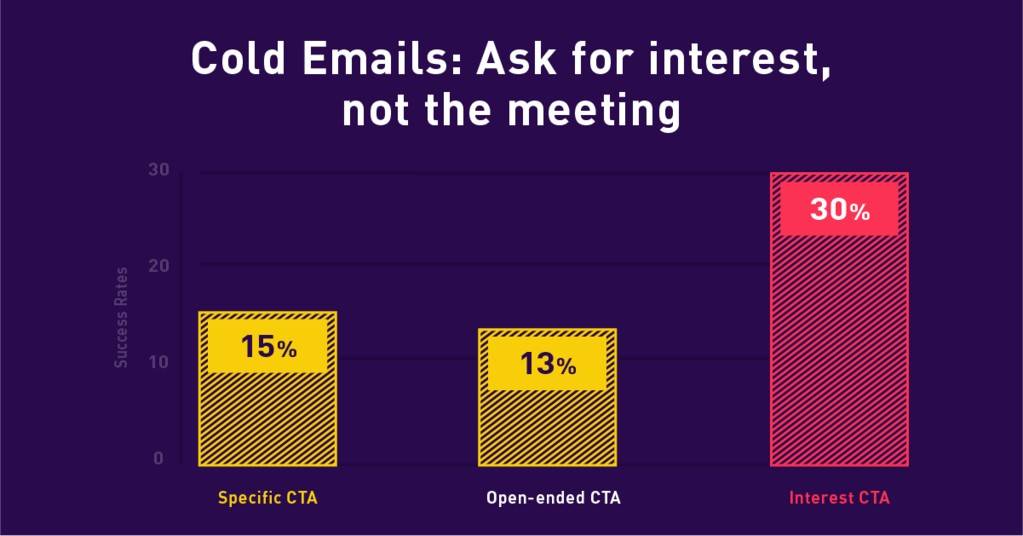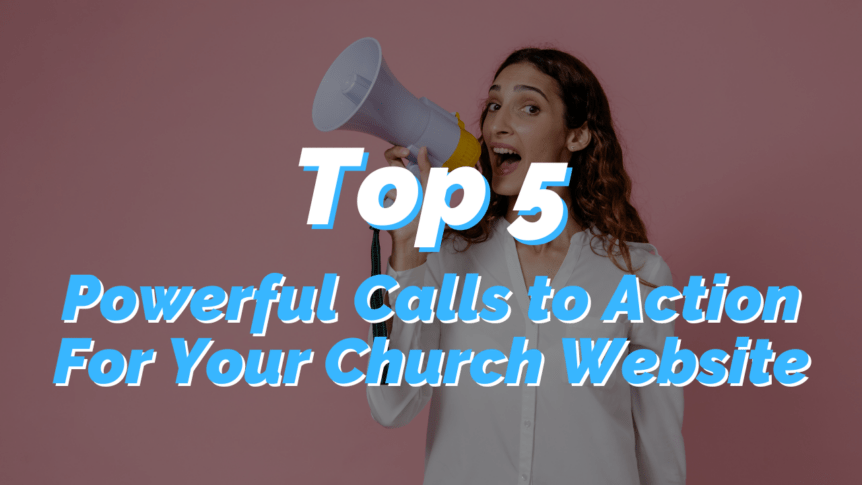A strong call to action is the foundation of every great marketing effort. Giving people information isn’t worth much if there’s nothing they can do about it. We see these calls to action everywhere every day, from ads telling us to “Buy Now!” to influencers telling us to follow, like, or subscribe to sermons on Sunday giving us practical applications for the message. A call to action actually gets people to do things.
So why aren’t there any on your church website? In this article, we’re going to explore calls to action, and how you can use them effectively on your website to grab the attention of visitors and get them to interact with your church. Then, we’re going to go over the top five calls to action you can use on your website to get the results you want.
Ready to learn more? Let’s dive in.
Estimated reading time: 10 minutes
Table of contents
Call to Action for Churches

Let’s start first with an overview of calls to action. You’ve most likely heard the term before, but let’s go deeper than that. What’s the point, why is it effective, and why should you care? We want to help your website stand apart from all other church websites and get as much traffic as possible. If that’s what you want too, let’s jump in.
What Exactly is a Call to Action?
For those who might be unfamiliar with the term, a call to action is where the marketer asks the person who is being engaged to respond with a desired action. It tells the person what they do next if they want the benefits that are being described in the piece. In web development, a good call to action is the difference between a site that works and one that doesn’t.
Successful businesses understand the importance of having a strong call to action on every page of their website. They are there to direct the site visitor to take the next desired step in the process of becoming a customer. As a few examples, they usually look like buttons or forms that say “Buy Now”, “Join Our Mailing List”, or “Download Our Free E-Book”. Every good website has to have a goal that you want visitors to complete, and for best results, you need to ask visitors to complete that goal with a call to action.
According to Gong, the most effective call to action is an “interest call to action.”

This means that the button they’re pressing or the link they’re going to is promising to only show them more due to interest. It isn’t vague enough that they don’t know what they’re clicking on or so specific that they feel like they’re signing up for something immediately. This means that buttons that say things like “Learn More” can be more effective than something like “Join Now”.
Calls to Action for Churches
Knowing this, it is amazing to see how many churches do not have any kind of call to action on their website. Often church leaders take a much more hands-off approach. We figure we can just tell people some things about our church, how great we are, and how great Jesus is, and trust that our visitors will figure out what to do from there.
It’s not that we don’t understand the principle of calls to action. I am pretty sure that the first lesson I learned in my Preaching Practicum class was that every sermon needs to have a strong point of application. A sermon without a response is a bad sermon.
For some reason, this truth has not translated onto most church websites. They often dump information on visitors, but they don’t ask them to respond.
Calls to Action on Websites
If you want to build a website that doesn’t just look good but effectively turns more website visitors into Sunday morning visitors, you need to have strong calls to action. I have seen churches make this one little change on their website and double the number of visitors they see on Sundays.
If the primary goal of your church website is to attract more visitors (if we take the Gospel seriously it probably should be) then you need to take the time to create calls to action. Make sure not to have a cluttered website that distracts people from the clear calls to action. You want to just provide them with the relevant information they need to know that will get them interested in your church, then hit them with a call to action to get them involved.
We advise against any calls to action that may be too overwhelming or irrelevant for visitors who may be interested in your church. Someone who has yet to attend a service doesn’t want to “Join a Small Group” or “Donate Now”, since they don’t even know your church yet. Those buttons still have to exist on your website for members of your community, but don’t put them in places where the new visitors will be looking.
Top 5 Calls to Action for Church Websites

So that’s everything you need to know about calls to action. If you are scratching your head on where to start, here are the five calls to action that we have seen get the best results for churches. We have a personal connection to these, as we have seen them transform church websites from getting no traffic, to getting tons of traffic.
1. “Visit A Service”
This one is obvious and should go without saying, but I can’t tell you how often I see churches leave this out. Make a point on every page of your website to tell people to visit your church for a service. On your staff page, tell people that you want to meet them and to come out to a service. On your missions page, tell people how they can learn more at the info table after service and invite them to come by.
Be creative but you need to find a way to do this on every page.
2. “Like Us On Social”
I find that people are more careful than ever with their email address. They don’t like to give it out unless they have to. In most cases they are much more liberal with their social media accounts. We have found that people are three times more likely to follow you on Facebook than they are to subscribe to a church newsletter.
And that is good news. For most churches, a social follow is much more valuable than an email address. A social follow allows you to connect with your community multiple times per week. Try sending multiple emails per week and you will quickly find your messages in the spam folder.
If you can get website visitors to follow you on social, you will have hundreds of future opportunities to connect with them. A huge win.
Also, the larger your social footprint, the better your search results!
3. “Submit A Prayer”

Generally churches have a hard time finding good reasons for people to fill out a form on their websites. Most events take some kind of personal touch before people are going to get signed up.
The one exception I have seen is in prayer requests. People are often very happy to fill out a prayer request form in order to receive prayer. I have seen churches where this became the front door to the church. Someone in need of prayer would stop by the websites and fill out a prayer request form, and from there they church would begin a follow up process designed to get that person connect to the church and in a relationship with Jesus.
One thing I should mention about this call to action… You actually have to pray for those people. Build a team around it, and you may find that it will energize your prayer warriors.
4. “Register Your Kids”
Most children’s ministries on Sunday Mornings have some paperwork that first time visitors have to fill out. I visited a church not too long ago where it took almost 15 minutes to get my three kids signed in and settled in children’s church for the first time. We showed up on time and had missed most of worship by the time we got into the service.
This final call to action is one that I am just starting to see some very forward thinking churches use. Rather than bog people down with an extensive sign in process for their kids on Sunday morning, they call people to action on their website to get their kids signed up before they show up.
This is great because it saves everyone sometime, but it also sets up an informal commitment. By filling out that form they are essentially saying they will be there, and it allows you to prepare to receive them, and make sure your follow up process is tuned up.
5. “Watch Online”
Let’s be real: church isn’t the same as it used to be. Not to say it’s any worse, it’s just different. Especially since COVID for example, people have been interacting with church in all new ways. That includes watching church online.
Using “Watch Online” as a call to action on your church website is essential in today’s digital age. This feature allows people to join your services from anywhere. For people interested in your church, this is a way for them to see what you’re all about, without needing to go through the effort of getting ready for church and driving all the way there.
Incorporating a “Watch Online” option also opens your church to a broader audience. People who are curious about your church can explore your services online before deciding to visit in person. This can be a welcoming first step for new visitors, making them feel more comfortable and informed.
Google Analytics can provide valuable insights into how your “Watch Online” feature is being used. By analyzing the data, you can see which services are most popular, what times attract the most viewers, and where your audience is located. These insights help you make specific actions to improve your online offerings, such as adjusting service times or focusing on topics that resonate most with viewers.
Ultimately, “Watch Online” is a simple yet powerful call to action that enhances accessibility and engagement. It ensures that your church can reach and support both current members and potential newcomers, no matter where they are.
Church Website Calls to Action

In conclusion, effective calls to action on your church website are crucial for fostering connection and engagement. Inviting visitors to “Visit a Service” encourages firsthand experience of your community. Encouraging people to “Like Us on Social” helps build a digital following and keeps them informed about church activities. Offering a “Submit a Prayer” option shows your church’s commitment to supporting and caring for its members and visitors.
Providing a “Register Your Kids” feature makes it easy for families to get involved in children’s programs, fostering a sense of belonging from a young age. Lastly, the “Watch Online” option ensures everyone can participate in services, regardless of location or circumstances. Each of these calls to action serves a unique purpose, but together they create a welcoming and inclusive environment that helps your church grow and thrive in the digital age.
These are the five calls to action that we have seen get the best results. Do you have a call to action on your website that works well? Did I miss any you can think of? Let us know in the comments below!
P.S. – In case you missed it, that was my call to action 🙂




